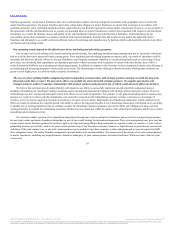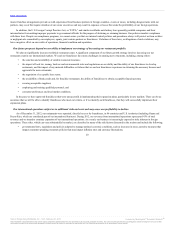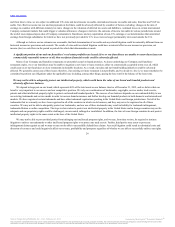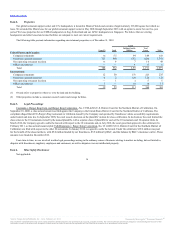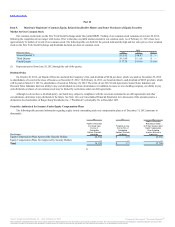Burger King 2012 Annual Report Download - page 23
Download and view the complete annual report
Please find page 23 of the 2012 Burger King annual report below. You can navigate through the pages in the report by either clicking on the pages listed below, or by using the keyword search tool below to find specific information within the annual report.
Table of Contents
As a result of entering into these hedging contracts with major financial institutions, we may be subject to counterparty nonperformance risk. Should
there be a counterparty default, we could be exposed to the net losses on the hedged arrangements or be unable to recover anticipated net gains from the
transactions.
Our profitability and the profitability of our franchisees depend in part on our ability to anticipate and react to changes in food and supply costs. The
market for beef and chicken is particularly volatile and is subject to significant price fluctuations due to seasonal shifts, climate conditions, demand for corn
(a key ingredient of cattle and chicken feed), corn ethanol policy, industry demand, international commodity markets, food safety concerns, product recalls,
government regulation and other factors, all of which are beyond our control and, in many instances unpredictable. If the price of beef, chicken or other
products that we use in our Company restaurants increases in the future and we choose not to pass, or cannot pass, these increases on to our guests, our
operating margins would decrease for as long as we operate Company restaurants. In addition, if commodity prices rise, franchisees may experience reduced
sales due to decreased consumer demand at retail prices that have been raised to offset increased commodity prices, which may reduce franchisee profitability.
Any such decline in franchisee sales will reduce our royalty income, which in turn may materially and adversely affect our business and operating results.
Our restaurant reimaging initiative depends on the ability, and willingness, of franchisees to accelerate the remodeling of their existing restaurants. We
have implemented a more cost effective remodeling solution which focuses spending on improvements that we believe will drive meaningful sales lifts to
maximize return on capital. However, our franchisees may not be willing to commit to engage in such remodeling. The average cost to remodel a stand-alone
restaurant in the United States is approximately $300,000 and the average cost to replace the existing building with a new building is approximately $1.2
million. Even if they are willing to participate, many of our franchisees will need to borrow funds in order to finance these capital expenditures. We do not
provide our franchisees with financing and therefore their ability to access borrowed funds depends on their independent relationships with various regional
and national financial institutions. If our franchisees are unable to obtain financing at commercially reasonable rates, or not at all, they may be unwilling or
unable to invest in the reimaging of their existing restaurants, and our future growth could be adversely affected. We currently offer, and may in the future
continue to offer, our franchisees financial incentives and access to third-party financing programs in order to accelerate our restaurant reimaging initiatives.
However, the cost of these financial incentives may have an adverse impact on our franchise revenues and operating results.
Food safety is a top priority, and we dedicate substantial resources to ensure that our customers enjoy safe, quality food products. However, food-borne
illnesses, such as E. coli, bovine spongiform encephalopathy or “mad cow disease,” hepatitis A, trichinosis or salmonella, and food safety issues have
occurred in the food industry in the past, and could occur in the future. Furthermore, our reliance on third-party food suppliers and distributors increases the
risk that food-borne illness incidents could be caused by factors outside of our control and that multiple locations would be affected rather than a single
restaurant. New illnesses resistant to any precautions may develop in the future, or diseases with long incubation periods could arise, such as mad cow
disease, which could give rise to claims or allegations on a retroactive basis. Any report or publicity linking us or one of our franchisees to instances of food-
borne illness or other food safety issues, including food tampering or contamination, could adversely affect our brands and reputation as well as our revenues
and profits. Outbreaks of disease, as well as influenza, could reduce traffic in our stores. If our customers become ill from food-borne illnesses, we could also
be forced to temporarily close some restaurants. In addition, instances of food-borne illness, food tampering or food contamination occurring solely at
restaurants of competitors could adversely affect our sales as a result of negative publicity about the foodservice industry generally.
22
Source: Burger King Worldwide, Inc., 10-K, February 22, 2013 Powered by Morningstar® Document Research℠
The information contained herein may not be copied, adapted or distributed and is not warranted to be accurate, complete or timely. The user assumes all risks for any damages or losses arising from any use of this
information, except to the extent such damages or losses cannot be limited or excluded by applicable law. Past financial performance is no guarantee of future results.









